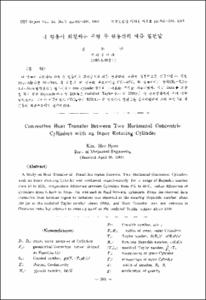燒却爐 排出가스의 大氣汚染 豫測 및 制御를 위한 分散모델링 방법론
- Alternative Title
- Dispersion Modeling Methodology for Air Pollution Prediction and Control of Incinerator Gas Emissions
- Abstract
- 본 연구의 목적은 공단지역의 대형 폐기물 소각로에서 배출되는 다양한 대기오염물의 기상 및 지형조건의 변화에 따른 지표면 착지농도를 예측하고 대기오염물의 대기중 이동 및 분산유형을 고찰하여 대기질 영향을 예측·평가하는 방법론을 개발함으로써 대기오염 저감을 위한 관리방안을 수립하기 위한 것이다.
울산의 실제 기상자료와 오염배출량 및 굴뚝특성자료를 ISCST 분산모델에 입력하여 소각로에서 배출되는 대기오염물질들의 대기질에 미치는 영향을 예측하고, 배출허용기준 및 설계기준에 따른 소각로의 굴뚝특성을 변화시키면서 대기오염저감 관리방안을 고찰하였다.
본 연구에서는 굴뚝배출특성을 변화시키면서 대기질 저감을 위한 최적의 굴뚝설계에 대한 분산모델링 방법론을 개발하였으며, 본 모델링 방법론은 공단에서 배출된 대기오염물질들의 제어 및 예측을 위해 저감대책을 위한 전략수립시 예비지침서로 사용될 수 있을 것이다.
The objective of this study is to predict the ground-level concentration of various air pollutants emitted at a large-scale waste incinerator in industrial complex sites, varying with meterological and topographical conditions, and to consider transport and dispersion patterns in air of pollutants, and finally to establish the management strategy for air pollution reduction by developing a methodology for predicting and estimating the effects of air quality.
By incorporating the actual meteorological data, source emissions and stack
characteristics into the ISCST dispersion model, this study predicted the effects of air pollutants emitted at the incinerator on air quality, and considered the management strategy for air pollution reduction varying with stack characteristics of the incinerator.
This study developed the dispersion modeling methodology on optimal stack design for reduction of air quality by varying stack characteristics, and this modeling methodology can be used as a preliminary guideline in establishing the reduction management strategy for control and prediction of air pollutants at industrial complex sites.
The objective of this study is to predict the ground-level concentration of various air pollutants emitted at a large-scale waste incinerator in industrial complex sites, varying with meterological and topographical conditions, and to consider transport and dispersion patterns in air of pollutants, and finally to establish the management strategy for air pollution reduction by developing a methodology for predicting and estimating the effects of air quality.
By incorporating the actual meteorological data, source emissions and stack
characteristics into the ISCST dispersion model, this study predicted the effects of air pollutants emitted at the incinerator on air quality, and considered the management strategy for air pollution reduction varying with stack characteristics of the incinerator.
This study developed the dispersion modeling methodology on optimal stack design for reduction of air quality by varying stack characteristics, and this modeling methodology can be used as a preliminary guideline in establishing the reduction management strategy for control and prediction of air pollutants at industrial complex sites.
- Issued Date
- 1995
- Type
- Research Laboratory
- Publisher
- 공학연구논문집
- Language
- kor
- Rights
- 울산대학교 저작물은 저작권에 의해 보호받습니다.
- Citation Volume
- 26
- Citation Number
- 1
- Citation Start Page
- 353
- Citation End Page
- 360
- Appears in Collections:
- Research Laboratory > Engineering Research
- 파일 목록
-
-
Download
 000002024010.pdf
기타 데이터 / 201.05 kB / Adobe PDF
000002024010.pdf
기타 데이터 / 201.05 kB / Adobe PDF
-
Items in Repository are protected by copyright, with all rights reserved, unless otherwise indicated.